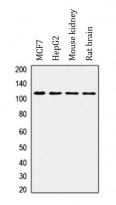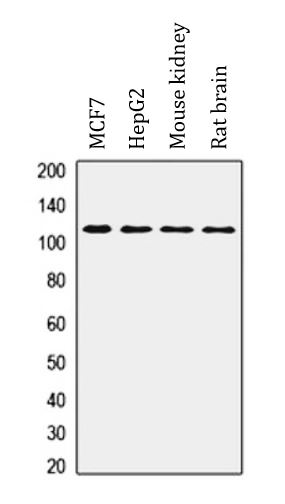anti-PKD2 / Polycystin 2 antibody
CAT.NO. : ARG40884
US$ Please choose
US$ Please choose
Size:
Trail, Bulk size or Custom requests Please contact us
*产品价格可能会有所调整,请以品牌方官网实时更新的价格为准,以确保准确性。
概述
| 产品描述 | Rabbit Polyclonal antibody recognizes PKD2 / Polycystin 2 |
|---|---|
| 反应物种 | Hu, Ms, Rat |
| 应用 | WB |
| 宿主 | Rabbit |
| 克隆 | Polyclonal |
| 同位型 | IgG |
| 靶点名称 | PKD2 / Polycystin 2 |
| 抗原物种 | Human |
| 抗原 | Recombinant full length protein of Human Polycystin 2. |
| 偶联标记 | Un-conjugated |
| 別名 | Polycystwin; APKD2; Autosomal dominant polycystic kidney disease type II protein; PC2; Pc-2; Polycystic kidney disease 2 protein; R48321; TRPP2; Polycystin-2; PKD4; Transient receptor potential cation channel subfamily P member 2 |
应用说明
| 应用建议 |
| ||||
|---|---|---|---|---|---|
| 应用说明 | * The dilutions indicate recommended starting dilutions and the optimal dilutions or concentrations should be determined by the scientist. | ||||
| 实际分子量 | 110 kDa |
属性
| 形式 | Liquid |
|---|---|
| 纯化 | Affinity purification with immunogen. |
| 缓冲液 | 0.42% Potassium phosphate (pH 7.3), 0.87% NaCl, 0.01% Sodium azide and 30% Glycerol. |
| 抗菌剂 | 0.01% Sodium azide |
| 稳定剂 | 30% Glycerol |
| 存放说明 | For continuous use, store undiluted antibody at 2-8°C for up to a week. For long-term storage, aliquot and store at -20°C. Storage in frost free freezers is not recommended. Avoid repeated freeze/thaw cycles. Suggest spin the vial prior to opening. The antibody solution should be gently mixed before use. |
| 注意事项 | For laboratory research only, not for drug, diagnostic or other use. |
生物信息
| 数据库连接 | |
|---|---|
| 基因名称 | PKD2 |
| 全名 | polycystic kidney disease 2 (autosomal dominant) |
| 背景介绍 | This gene encodes a member of the polycystin protein family. The encoded protein is a multi-pass membrane protein that functions as a calcium permeable cation channel, and is involved in calcium transport and calcium signaling in renal epithelial cells. This protein interacts with polycystin 1, and they may be partners in a common signaling cascade involved in tubular morphogenesis. Mutations in this gene are associated with autosomal dominant polycystic kidney disease type 2. [provided by RefSeq, Mar 2011] |
| 生物功能 | Functions as a calcium permeable cation channel involved in fluid-flow mechanosensation by the primary cilium in renal epithelium. Together with TRPV4, forms mechano- and thermosensitive channels in cilium. PKD1 and PKD2 may function through a common signaling pathway that is necessary for normal tubulogenesis. Acts as a regulator of cilium length, together with PKD1. The dynamic control of cilium length is essential in the regulation of mechanotransductive signaling. The cilium length response creates a negative feedback loop whereby fluid shear-mediated deflection of the primary cilium, which decreases intracellular cAMP, leads to cilium shortening and thus decreases flow-induced signaling. Also involved in left/right axis specification downstream of nodal flow: forms a complex with PKD1L1 in cilia to facilitate flow detection in left/right patterning (By similarity). [UniProt] |
| 细胞定位 | Cell projection, cilium membrane. Endoplasmic reticulum membrane. Cell membrane. Basolateral cell membrane. Cytoplasmic vesicle membrane. Note=Retained in the endoplasmic reticulum by interaction with PACS1 and PACS2 (PubMed:15692563). Detected on kidney tubule basolateral membranes and basal cytoplasmic vesicles (PubMed:10770959). Cell surface and cilium localization requires GANAB (PubMed:27259053). [UniProt] |
| 预测分子量 | 110 kDa |
| 翻译后修饰 | Phosphorylated. Phosphorylation is important for protein function; a mutant that lacks the N-terminal phosphorylation sites cannot complement a zebrafish pkd2-deficient mutant (PubMed:16551655). PKD-mediated phosphorylation at the C-terminus regulates its function in the release of Ca(2+) stores from the endoplasmic reticulum (PubMed:20881056). PKA-mediated phosphorylation at a C-terminal site strongly increases the open probability of the channel, but does not increase single channel conductance (PubMed:26269590). N-glycosylated. The four subunits in a tetramer probably differ in the extent of glycosylation; simultaneous glycosylation of all experimentally validated sites would probably create steric hindrance. Thus, glycosylation at Asn-305 is not compatible with glycosylation at Asn-328; only one of these two residues is glycosylated at a given time. [UniProt] |
 New Products
New Products





















